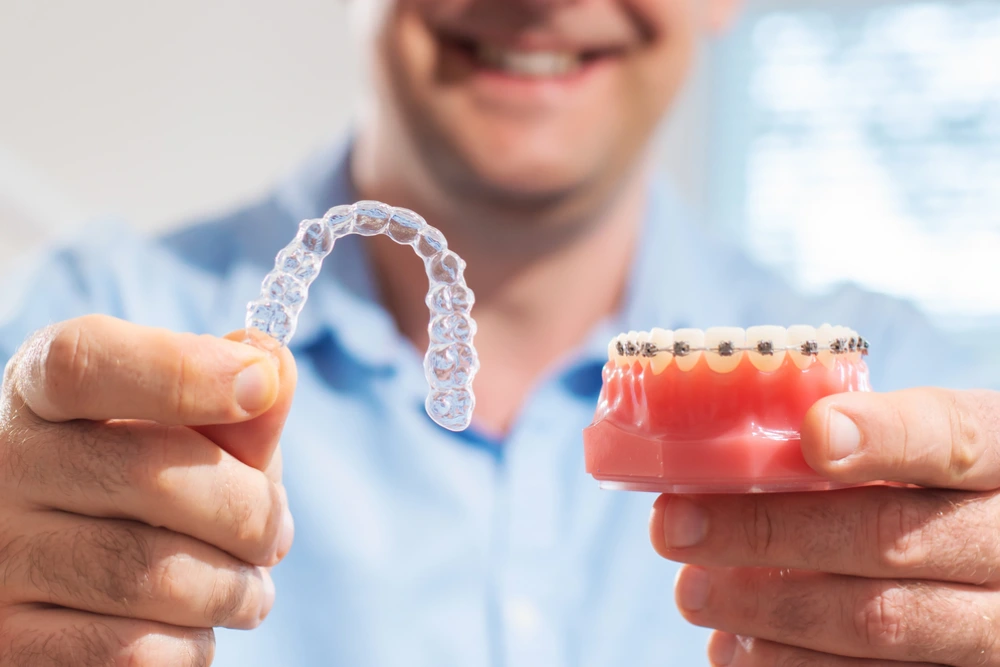
Have you ever wondered what the difference is between braces and Invisalign? Well, you’ve come to the right place! Today, we’ll delve into the nitty-gritty of these two popular orthodontic treatments, so you can make an informed decision on your path to a straighter, more dazzling smile. Let’s jump right in, shall we?
Traditional Braces: Old School, but Gold School
You might have seen them in movies or even on your friends: those shiny metal brackets cemented to teeth, connected by wires and colorful elastics. Yep, we’re talking about traditional braces. They’ve been around for ages, but don’t be fooled – they’re still one of the most effective ways to fix a wide range of dental issues. Here are some of the key characteristics of braces:
- Materials: Braces are typically made of metal or ceramic brackets, with a wire that runs through them. You can even customize the color of the elastics if you’re feeling extra stylish.
- Adjustment: Brace yourselves! (pun intended) You’ll need to visit your orthodontist every 4-6 weeks for adjustments. They’ll tighten the wires, which gradually move your teeth into the desired position.
- Maintenance: Get ready to show those pearly whites some extra love! Braces require diligent oral hygiene, including flossing with special tools, using a Waterpik, and brushing around the brackets.
Braces Pros and Cons
Before we move on to Invisalign, let’s quickly go over the pros and cons of braces:
Pros:
- Effective for a wide range of dental issues, including severe cases
- Durable and reliable
- Often more affordable than Invisalign
- Can be customized with different colors for a fun look
Cons:
- More noticeable due to the metal or ceramic components
- Can cause discomfort or irritation
- Require more diligent oral hygiene and dietary restrictions
Invisalign: The Clear Contender
Now, let’s talk about the new kid on the block: Invisalign. In recent years, this virtually invisible treatment has been gaining popularity, and for good reason! Here’s what makes Invisalign stand out:
- Materials: Invisalign uses clear, BPA-free plastic aligners that are custom-made to fit snugly over your teeth.
- Treatment Process: You’ll receive a series of aligners, each designed to move your teeth incrementally. You’ll wear each set for about two weeks before moving on to the next one in the series.
- Removability: Unlike braces, Invisalign aligners are removable. This means you can take them out to eat, drink, brush, and floss – making your daily routine a breeze.
- Aesthetics: Since Invisalign aligners are clear and nearly invisible, they’re an excellent option for those who want a more discreet orthodontic treatment.
Invisalign Pros and Cons
Now that we’ve covered the basics of Invisalign, let’s take a look at its pros and cons:
Pros:
- Nearly invisible, making it a more discreet treatment option
- Removable, allowing for easier eating and oral hygiene
- Typically more comfortable due to the smooth plastic aligners
- Fewer restrictions on foods and activities.
Cons:
- Not suitable for all dental issues, especially severe or complex cases
- May be more expensive than traditional braces
- Requires discipline to wear the aligners for the recommended 20-22 hours per day
- Aligners need to be cleaned regularly to prevent staining or odor
Braces vs Invisalign: Comparing the Key Differences
While both braces and Invisalign aim to straighten your teeth and improve your smile, they do so through different methods and materials. So, what is the difference between braces and Invisalign? Let’s break it down:
- Aesthetics: Braces are more noticeable due to their metal or ceramic components, while Invisalign is nearly invisible thanks to its clear aligners.
- Removability: Invisalign is removable, allowing for easier eating and oral hygiene, whereas braces are fixed to your teeth throughout the treatment.
- Treatment Time: Treatment times may vary, but braces typically require a longer commitment, ranging from 18-24 months. Invisalign, on the other hand, can sometimes achieve results in as little as 6-18 months, depending on the complexity of the case.
- Comfort: Some people find Invisalign more comfortable due to its smooth plastic aligners, whereas braces can sometimes cause irritation from the metal or ceramic brackets and wires.
- Suitability: Braces can correct a wider range of orthodontic issues, including severe cases of misalignment, bite issues, and overcrowding. Invisalign is better suited for mild to moderate cases, and may not be the best choice for complex dental issues.
Choosing the Right Treatment for You: Braces vs Invisalign?
So, what is the difference between braces and Invisalign, and which one should you choose? Ultimately, the best choice for you will depend on your individual needs, preferences, and lifestyle. Here are some factors to consider when making your decision:
- Your Dental Issues: Consult with an orthodontist to determine the complexity of your case and whether braces or Invisalign would be more suitable for your needs.
- Aesthetics: If you’re concerned about the visibility of your orthodontic treatment, Invisalign’s nearly invisible aligners might be a better choice for you.
- Lifestyle: Consider how your orthodontic treatment might impact your daily life. If you play contact sports, have a busy social life, or would find removable aligners inconvenient, braces might be a better fit.
- Budget: Invisalign tends to be more expensive than traditional braces, so it’s important to consider your budget when making your decision.
In conclusion, the main difference between braces and Invisalign lies in their materials, methods, and aesthetic appeal. While braces remain a reliable and effective solution for various dental issues, Invisalign offers a more discreet and comfortable alternative for those who qualify. It’s essential to consult with an orthodontist to determine which option is best suited for your unique needs and preferences.
